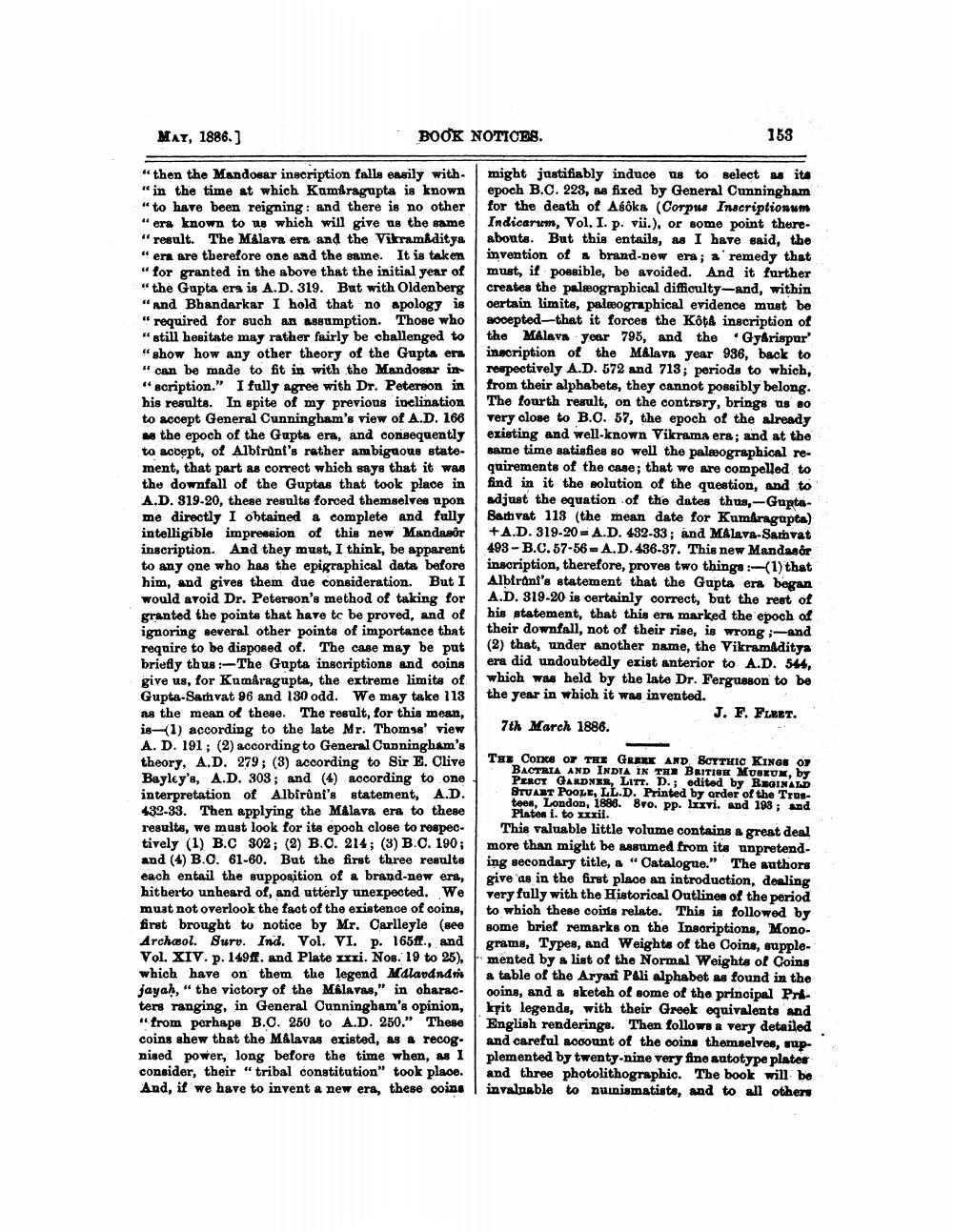________________
MAY, 1886)
BOOK NOTICES.
153
“then the Mandosar inscription falls easily with "in the time at which Kamiragupta is known " to have been reigning: and there is no other " era known to be which will give us the same "result. The MAlava era and the Vikramiditya "ern are tberefore one and the same. It is taken " for granted in the above that the initial year of "the Gupta era is A.D. 319. But with Oldenberg "And Bhandarkar I hold that no apology is "required for such an assumption. Those who "still hesitate may rather fairly be challenged to "show how any other theory of the Gupta era " can be made to fit in with the Mandosar in "scription." I fully agree with Dr. Peterson in his results. In spite of my previous inclination to accept General Cunningham's view of A.D. 166 us the epoch of the Gupta era, and consequently to accept, of Albfrúni's rather ambiguous state. ment, that part as correct which says that it was the downfall of the Guptas that took place in A.D. 319-20, these results forced themselves upon me directly I obtained a complete and fully intelligible impression of this new Mandasor inscription. And they must, I think, be apparent to any one who has the epigraphical data before him, and gives them due consideration. But I would avoid Dr. Peterson's method of taking for granted the points that have to be proved, and of ignoring several other points of importance that require to be disposed of. The case may be put briefly thus :-The Gupta inscriptions and coins give us, for Kumáragupta, the extreme limits of Gupta-Sarhvat 96 and 180 odd. We may take 113 as the mean of these. The result, for this mean, is-1) according to the late Mr. Thomse' view A. D. 191 ; (2) according to General Cunningham's theory, A.D. 279; (3) according to Sir E. Clive Bayley's, A.D. 303; and (4) according to one interpretation of Albirûni's statement, A.D. 432-33. Then applying the Malava era to these results, we must look for its epoch close to respectively (1) B.C 302; (2) B.C. 214; (3) B.C. 190; and (4) B.C. 61-60. But the first three results each entail the supposition of a brand-new era, hitherto unheard of, and utterly unexpected. We must not overlook the fact of the existence of coins, first brought to notice by Mr. Carlleyle (see Archæol. Suro. Ind. Vol. VI. p. 165ft., and Vol. XIV. p. 149ff. and Plate xxi. Nos. 19 to 25), which have on them the legend Malavdndi jayah," the victory of the Malavas," in charac. ters ranging, in General Cunningham's opinion, " from perhape B.C. 250 to A.D. 250." These coins shew that the Malavas existed, as a recog. nised power, long before the time when, as I consider, their "tribal constitution" took place. And, if we have to invent a new era, these coins
might justifiably induce us to select as its epoch B.C. 223, as fixed by General Cunningham for the death of Asoka (Corpus Inscriptionum Indicarum, Vol. I. p. vii.), or some point thereabouts. But this entails, as I have said, the invention of a brand-new era; a remedy that must, if possible, be avoided. And it further creates the palæographical difficulty-and, within oertain limite, palæographical evidence must be accepted-that it forces the Kota inscription of the MAlava year 795, and the Gyárispor' inscription of the Malava year 936, back to respectively A.D. 572 and 713; periods to which, from their alphabets, they cannot possibly belong. The fourth result, on the contrary, brings us so very close to B.C. 57, the epoch of the already existing and well-known Vikrama era; and at the same time satisfies so well the palæographical requirements of the case; that we are compelled to find in it the solution of the question, and to adjust the equation of the dates thus,-- GuptaBathvat 113 (the mean date for Kumaragupta)
+A.D. 319-20 = A.D. 432-33; and Málava-Sarvat 493 - B.C. 57-56 - A.D. 436-37. This new Mandasör inscription, therefore, proves two things :-(1) that Albtrani's statement that the Gupta era began A.D. 819-20 is certainly correct, but the rest of his statement, that this era marked the epoch of their downfall, not of their rise, is wrong ;-and (2) that, under another name, the Vikramaditya era did undoubtedly exist anterior to A.D. 544. which was held by the late Dr. Fergusson to be the year in which it was invented.
J. F. FLEET. 7th March 1886.
THE Corks OF THE GREEK AND SOYTHIC KINGS OF
BACTRIA AND INDIA IN TE BRITISH MUSEUX, by PERCY GARDNER, LITT. D.; edited by REGINALD STUART POOLE, LL.D. Printed by order of the Trosteen, London, 1896. 8vo. pp. lxxvi. and 198 ; and Plates i. to xxxii. This valuable little volume contains a great deal more than might be assumed from its unpretend. ing secondary title, a "Catalogue." The authors give as in the first place an introduction, dealing very fully with the Historical Outlines of the period to which these coiris relate. This is followed by some brief remarks on the Inscriptions, Monograms, Types, and Weights of the Coins, supplemented by a list of the Normal Weights of Coins a table of the Aryan Pali alphabet as found in the ooing, and a sketch of some of the principal Prekpit legends, with their Greek equivalents and English renderings. Then follows a very detailed and careful account of the coins themselves, rapplemented by twenty-nine very fine autotype plates and three photolithographic. The book will be invaluable to numismatiste, and to all others




